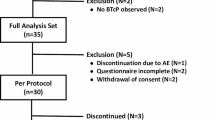Abstract
Background and Objective: Breakthrough pain describes transient exacerbations of pain that occur in cancer patients with adequately controlled background pain. Transmucosal fentanyl administration produces rapid-onset and short-duration analgesia that is effective for treating patients with breakthrough pain. Although a significant amount of research has been devoted to the study of speed of analgesia onset of transmucosal fentanyl products, few data exist on their variability in absorption, particularly within the same individual, despite the importance of this characteristic to the dose-to-dose reliability of their analgesic effect. This cross-study analysis aimed to evaluate the intra- and interindividual pharmacokinetic differences of fentanyl administered via fentanyl buccal soluble film in healthy subjects.
Methods: Data were evaluated from 24 subjects in two pharmacokinetic studies of fentanyl administered via fentanyl buccal soluble film (Breakyl®/Onsolis™; BEMA® [BioErodible MucoAdhesive] technology). In one study, 12 healthy subjects received 600 µg doses of fentanyl as single film on two separate occasions; in the second study, 12 different healthy subjects received 800 µg doses of fentanyl on two separate occasions, one as a single 800 µg film and the other as four 200 µg films.
Results: The analysis showed a minimal intraindividual variability and a relatively higher interindividual variability in pharmacokinetic parameters (i.e. maximum plasma concentration, area under the plasma concentration-time curve from time zero to infinity). The coefficient of variation for intraindividual exposure to fentanyl variability was 7–10%, and for interindividual variability was 23–39%.
Conclusion: The minimal intraindividual variability in fentanyl absorption from the buccal soluble film demonstrates a predictable dose-to-dose exposure, which is a very desirable attribute for a medicine that is intended to treat breakthrough cancer pain, suggesting that this product would be expected to produce consistent effects in clinical practice. The greater interindividual variability highlights the need for individual titration of this product (as occurs with similar transmucosal fentanyl products), and for the availability of an adequately wide dose range.




Similar content being viewed by others
References
Davies AN, Dickman A, Reid C, et al. The management of cancer-related breakthrough pain: recommendations of a task group of the Science Committee of the Association for Palliative Medicine of Great Britain and Ireland. Eur J Pain 2009 Apr; 13(4): 331–8
Zeppetella G. Impact and management of breakthrough pain in cancer. Curr Opin Support Palliat Care 2009 Mar; 3(1): 1–6
Twycross R, Wilcock A. Palliative care formulary. 3rd ed. Oxford: Oxford University Press, 2007
Grape S, Schug SA, Lauer S, et al. Formulations of fentanyl for the management of pain. Drugs 2010; 70(1): 57–72
Madhav NV, Shakya AK, Shakya P, et al. Orotransmucosal drug delivery systems: a review. J Control Release 2009 Nov 16; 140(1): 2–11
Streisand JB, Varvel JR, Stanski DR, et al. Absorption and bioavailability of oral transmucosal fentanyl citrate. Anesthesiology 1991 Aug; 75(2): 223–9
Darwish M, Kirby M, Robertson Jr P, et al. Absolute and relative bioavailability of fentanyl buccal tablet and oral transmucosal fentanyl citrate. J Clin Pharmacol 2007 Mar; 47(3): 343–50
Vasisht N, Gever LN, Tagarro I, et al. Formulation selection and pharmacokinetic comparison of fentanyl buccal soluble film with oral transmucosal fentanyl citrate: a randomized, open-label, single-dose, crossover study. Clin Drug Investig 2009; 29(10): 647–54
Vasisht N, Gever LN, Tagarro I, et al. Evaluation of the single- and multiple-dose pharmacokinetics of fentanyl buccal soluble film in normal healthy volunteers. J Clin Pharmacol 2010; 50(7): 785–91
Vasisht N, Gever LN, Tagarro I, et al. Single-dose pharmacokinetics of fentanyl buccal soluble film. Pain Med 2010; 11(7): 1017–23
Rauck R, North J, Gever LN, et al. Fentanyl buccal soluble film (FBSF) for breakthrough pain in patients with cancer: a randomized, double-blind, placebo-controlled study. Ann Oncol 2010 Jun; 21(6): 1308–14
Skinner C, Thompson E, Davies A. Clinical features. In: Davies A, editor. Cancer-related breakthrough (episodic) pain. Oxford: Oxford University Press, 2006
Data on file. Clinical study report FEN-202: an open-label, long-term treatment evaluation of the safety of BEMA™ Fentanyl use for breakthrough pain in cancer patients on chronic opioid therapy. BioDelivery Sciences International Inc., 2007
Zeppetella G. Is the recommended titration schedule for OTFC too conservative? Eur J Palliative Care 2005; 12 (Suppl.): 4–6
Data on file. Clinical study report FEN-110: an evaluation of the single dose pharmacokinetics of BEMA™ Fentanyl. Raleigh (NC): BioDelivery Sciences International Inc., 2007
Onsolis prescribing information. 2.1 Dose titration. Madrid: Meda Pharmaceuticals Inc., 2009
Acknowledgements
Funding for the design and conduct of this study and for the collection, management and analysis of the resulting data was provided by BioDelivery Sciences International. Funding for the manuscript preparation was provided by Meda Pharma. We thank Dr David Blum for his valuable contribution and Bill Wargin (PK-PM Associates LLC) for his assistance and input into this manuscript. We also thank Ray Hill of inScience Communications, a Wolters Kluwer business, who provided editing assistance and journal styling prior to submission. This assistance was funded by Meda Pharma.
Andrew Davies has previously undertaken consultancy work for Meda Pharma, Archimedes, Cephalon, Nycomed and Prostrakan. Andrew Finn is an employee of BioDelivery Sciences. Ignacio Tagarro is an employee of Meda Pharma.
Author information
Authors and Affiliations
Corresponding author
Rights and permissions
About this article
Cite this article
Davies, A., Finn, A. & Tagarro, I. Intra- and Interindividual Variabilities in the Pharmacokinetics of Fentanyl Buccal Soluble Film in Healthy Subjects. Clin. Drug Investig. 31, 317–324 (2011). https://doi.org/10.1007/BF03256930
Published:
Issue Date:
DOI: https://doi.org/10.1007/BF03256930




